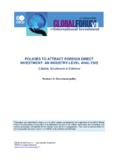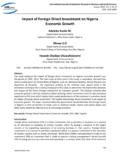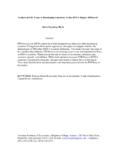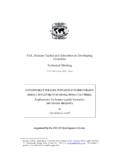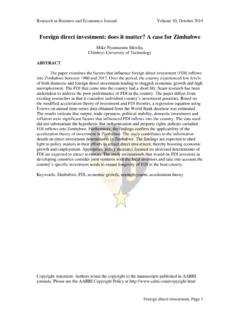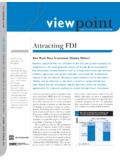Transcription of Introduction to 'Foreign Direct Investment'
1 This PDF is a selection from an out-of-print volume from the National Bureau of Economic Research Volume Title: foreign Direct investment Volume Author/Editor: Kenneth A. Froot, editor Volume Publisher: University of Chicago Press Volume ISBN: 0-226-26621-4. Volume URL: Conference Date: May 15, 1992. Publication Date: January 1993. Chapter Title: Introduction to " foreign Direct investment ". Chapter Author: Kenneth A. Froot Chapter URL: Chapter pages in book: (p. 1 - 12). Introduction Kenneth A. Froot foreign Direct investment (FDI) has grown dramatically as a major form of international capital transfer over the past decade. Between 1980 and 1990, world flows of FDI-defined as cross-border expenditures to acquire or ex- pand corporate control of productive assets-have approximately tripled.
2 FDI. has become a major form of net international borrowing for Japan and the United States (the world's largest international lender and borrower, respec- tively). Direct investment has grown even more rapidly of late within Europe. To what extent is this sudden worldwide surge in FDI explained by tradi- tional theories? These theories predict the scale and scope of multinational enterprises by looking to differences in competitive advantage, across firms or countries, that might lead to the extension of corporate control across borders. So, for example, better technology, management capability, and product de- sign; stronger consumer allegiance; and greater complementaritiesin produc- tion or use of technology can allow a domestic firm to control foreign assets more productively than would a foreign firm and could therefore predicate Direct investment .
3 In many cases, these theories also explain why an enter- prise's alternatives to FDI-domestically based production or licensing of foreign -based production-are less efficient than Direct control of foreign - based operations (see, , Caves 1982; Vernon 1966). Traditional theories are very useful for explaining basic long-term patterns of FDI. For example, they help understand the behavior of firms during the post-World War I1 period (the experience on which these theories were honed). At that time, advanced firms were superior in technology and well established in foreign markets. firms tended to move overseas to retain competitive access (or to preempt competitors' access) to those markets and, in the process, met with relatively little competition.
4 These theories also help us understand why the tide of FDI flows has slowly turned. The evolution of the United States from a home for domestically 1. 2 Kenneth A. Froot based multinationals to a host for foreign -based multinationals is probably the single most obvious sign of change in FDI today. This development basically coincides with the waning (and even disappearance) of firms' former competitive advantages. It is obvious to today's consumer that European-, Jap- anese, and Canadian-based firms have developed advantages that allow them to control certain assets in the United States more efficiently than would based firms. In spite of their successes, however, the traditional theories leave many re- cent features of FDI unexplained.
5 First, it is hard to believe that the tide of underlying competitive advantage followed closely (or at all) the behavior of total FDI flows over the last decade: very rapid increases from 1979 through 1981, strong declines from 1982 through 1985, and then increases of unprece- dented size from 1986 through 1990. One would have expected changes in national competitive advantages to be reflected in more steady trends. Second, to the extent that any developments happen quickly, one might have expected that they would occur in a single industry at a time-say, the automobile pro- ducers of Japan-as shocks to competitive ability come to be reflected in world ownership patterns. Yet the surges of the past fifteen years take place across virtually all industries simultaneously.
6 The recent FDI surges in inflows and Japanese outflows illustrate these two features. Japanese FDI overall, which historically was small, exploded across all industries in the latest surge, experiencing in the aggregate a seven- fold increase from 1985 to 1989. During this surge, both inflows and Japanese outflows were particularly large and fast-growing in real estate and financial services. In these industries, however, there was little evidence of meaningful change in competitive advantage. Particularly puzzling is the case of Japanese banks, which during the latest surge went on a much-publicized binge in acquiring foreign affiliates. Many of the involved banks were actually noted for their apparently inefficient operations and low profitability in com- parison with and European companies.
7 These facts suggest that existing theories do a good job of explaining neither the timing or magnitude of surges nor their broad cross-industry composition. Another group of theories, less well established, may help us understand the timing and cross-sectional behavior of surges. Tax changes may have had sud- den, large (sometimes unintended) across-the-board effects on the relative ( foreign versus domestic) profitability of asset control. Such effects are un- likely to be sustained for decades. Changes in corporate borrowing capacity and availability of internal funds may also help explain why some firms can invest or purchase assets more cheaply than others can even without a perceptible change in competitive advantage. Follow-the-leader tendencies, even if not completely rational, may influence corporate location decisions in the short run (although in the long run such decisions will presumably be more consistent with the underlying economics of production).
8 Strategically oriented location decisions (in goods 3 Introduction and factor markets which display imperfect competition) might be driven by conjectures about other firms' propensity to invest abroad and might therefore lead to rational herdlike behavior. Actual or existing trade barriers are also an important consideration (and are also stressed by more traditional theories). The essays in this volume assess these newer explanations as well as other, older theories. The chapters are grouped in order to attack the issue from a variety of perspectives. The first group comprises overview essays (by Paul Krugman and Monty Graham, Rachel McCulloch, and Raymond Vernon) that look at the broad FDI experience during the most recent period and contrast it with earlier trends.
9 The papers define the main issues and areas of change in FDI patterns and assess the performance of macrotheories. The second group deals with specific-country experiences. There are essays on Japan (Robert Lawrence), on the United States (Robert Lipsey), and on East Asian devel- oping countries (Louis Wells). One chapter analyzes the FDI experience along a different dimension, evaluating how the developments within a specific in- dustry-semiconductors-match up with those seen on a country or world- wide basis (David Yoffie). Another important characteristic of recent FDI is the mode by which it is accomplished. In the past, greenfield investment was the rule, but today the vast majority of FDI is done through mergers and acquisitions (M&A).
10 Why the sudden change? Older theories say little about the mechanics of FDI trans- actions; perhaps changes in financing technologies made acquisitions easier and resulted in a surge in M&A (domestic as well as foreign ). The growth in international merger and acquisition transactions has led re- searchers to study M&A on its own terms. One advantage of looking at acqui- sitions data is that purchase prices are flexible and, because they often are the result of competitive bidding, are meaningful as well. By contrast, the costs . of doing greenfield investment are rarely recorded and rarely reflect the invest- or's eagerness to proceed. By analyzing M&A transactions, we can learn some- thing about foreign investors' reservation prices and can compare them with the reservation prices of domestic investors.










